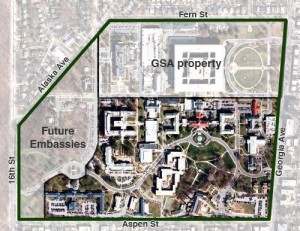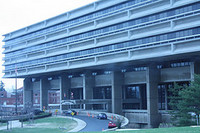Walter Reed closure could hurt Silver Spring
In Montgomery County, most of the discussion about the closing of Walter Reed centers on how to absorb the jobs that will go to the National Military Medical Center (NMMC) in Bethesda.
With about 1,400 jobs scheduled to move to NMMC and another 1,100 additional positions at the facility expected by 2020, MoCo has focused on how to handle the crush of new commuters. The shift of jobs from Walter Reed to Bethesda has some downside for Montgomery County, though — and not just because the roads around NMMC are already heavily congested.
Silver Spring is just a short drive up Georgia Avenue from Walter Reed, and the redevelopment of Silver Spring’s downtown has allowed Montgomery County to benefit from the economic activity generated by Walter Reed. Many of the soldiers at Walter Reed are recovering from injuries suffered in Iraq and Afghanistan, so the military personnel who frequent McGinty’s or visit Woodside Urban Park with their families tend to be a low-key presence. Nonetheless, their economic impact is significant.
A friend who works at a Silver Spring hotel tells me that her employer expects a $5 million a year revenue hit when Walter Reed closes. Silver Spring already has nine hotels, with more capacity coming in the medium term. Many companies have been scaling back business travel in favor of teleconferencing, so demand would probably be soft even without the loss of Walter Reed business and with a strong economic recovery.
That’s not to say that the closing of Walter Reed has to be bad for Silver Spring. In fact, DC has ambitious plans to redevelop the Walter Reed campus. Ideas for reuse include some combination of residential housing, offices, retail, space for non-profits, a WMATA bus garage, and recruitment of one or more new federal government tenants to replace the Army.
The District government also has been working for several years to refashion Upper Georgia Avenue (which they define as the 2.6 mile stretch from Decatur Street to the Maryland line) into a more inviting, vibrant corridor. These improvements would be good for both DC and MoCo.
Now might be a good time, though, for MoCo leaders to devote some thought to how we might cooperate (and in some cases compete against) the District to make sure we are prepared for the loss of Walter Reed.
To that end, here are some of the key issues for Montgomery County in the ongoing redevelopment of Upper Georgia Avenue and the Walter Reed campus:
Extending the beachhead of Silver Spring’s redevelopment. Complaints about chain restaurants notwithstanding, the redevelopment of Silver Spring around the intersection of Fenton and Ellsworth has been a huge success. The land use and streetscape along Georgia between the DC line and Walter Reed leaves a lot to be desired, but this part is the District’s responsibility, and the pressing economic development priority for Silver Spring is to encourage more activity in the area extending from Wayne Avenue to the border with DC.
The departure of Mayorga Coffee for Takoma Park was a blow to these efforts, but hundreds of new condominium and apartment units are coming online. Silver Spring is still an underserved restaurant and retail market, and the demand for entertainment and shopping choices is strong despite the economic downturn.
Improving transit access. A streetcar line once ran along Georgia Avenue, but the line was abandoned in the early sixties. Metro’s Red Line was built in the heavy rail corridor to well to the east from Union Station to Silver Spring, leaving the Georgia Avenue corridor without high quality transit, although bus service is available.
DC plans to build a street car line up Georgia within a few years, but current plans call for the northern end of the line to end at the Takoma Park Metro station rather than Silver Spring in order to keep the streetcar system within the city limits.
Montgomery County should consider how it might work with DC to connect to the streetcar line at some point in the future, and in the short term MoCo might want to study how to make bus service more appealing along Georgia Avenue.
Tearing down (or at least breaking up) the wall. Like most military bases, Walter Reed is closed off to the surrounding area by fencing and security gates, cutting off 14th Street to the south from the residential neighborhoods to the north. DC’s plans for the campus and for Georgia Avenue are based on sound concepts; namely, a mix of residential, office, and retail uses along an improved Georgia Avenue streetscape designed to make the area more attractive to pedestrians and less oriented around the needs of automobiles.
The problem is that the General Services Administration will retain 32.5 acres along the northern edge of the campus, and any prospective federal agency tenant for this space might well try to surround its buildings with a hermetically sealed security perimeter.

To the right is a diagram that shows the problem. If DC accedes to the desire of a new government tenant (or private developer, for that matter) to establish barriers to convenient public access through the campus, it will be missing an important opportunity to help integrate the redeveloped campus into the surrounding neighborhoods and to provide better connectivity to Silver Spring.
Some of the people who live immediately to the north probably would oppose any effort to reconnect the grid by extending 14th Street across the campus to their neighborhoods. However, access for pedestrians and bicyclists will benefit them if redevelopment of Walter Reed succeeds in expanding the retail and restaurant options on Georgia Avenue both north and south of the campus.
Marketing MoCo to people and businesses in northern DC. A few years ago, Baltimore bought advertising space in Metro stations to pitch the idea that Baltimore is an accessible and affordable alternative to paying outrageous sums to buy a rowhouse on Capitol Hill or in Dupont Circle.

One of the Baltimore ads.
MoCo is a much more plausible choice than Baltimore for most District residents, especially for those who work in the Upper Georgia Avenue corridor. MoCo housing is not cheap, although Silver Spring is still a bargain compared to Bethesda or Chevy Chase (or Arlington, for that matter).
Our schools, however, give us a huge advantage not just among families with children but for anyone concerned about the value of their investment in housing. Our schools may be overrated and DC may (or may not) press forward with the reforms started by Michelle Rhee, but for now the gap in performance remains large.
The advantages of living in Silver Spring are so obvious that they ought to sell themselves, but let’s not be shy about reminding people in DC about what we have to offer.
Silver Spring has a lot to lose if the redevelopment of Walter Reed and the improvements to the Georgia Avenue corridor run aground, and our county government should be working closely with the District to make these initiatives work.
Unfortunately, while we have a special office set up to coordinate the consolidation of Walter Reed jobs at Medical Center, we don’t seem to be paying much attention to how Silver Spring might be hurt by the loss of Walter Reed or how we might benefit from cooperating with the District to address the gap it leaves.
In 1997, MoCo and the District cooperated to help create the Gateway-Georgia Avenue Development Corporation, which worked to spur revitalization of the area between south Silver Spring and Walter Reed, but the effort appears to have petered out. Our political and business leaders should refocus their attention with the idea that the parts of DC on our southern border have got to be an integral part of our economic development plans for the future.
Cross-posted at Citizens League of Montgomery County.

